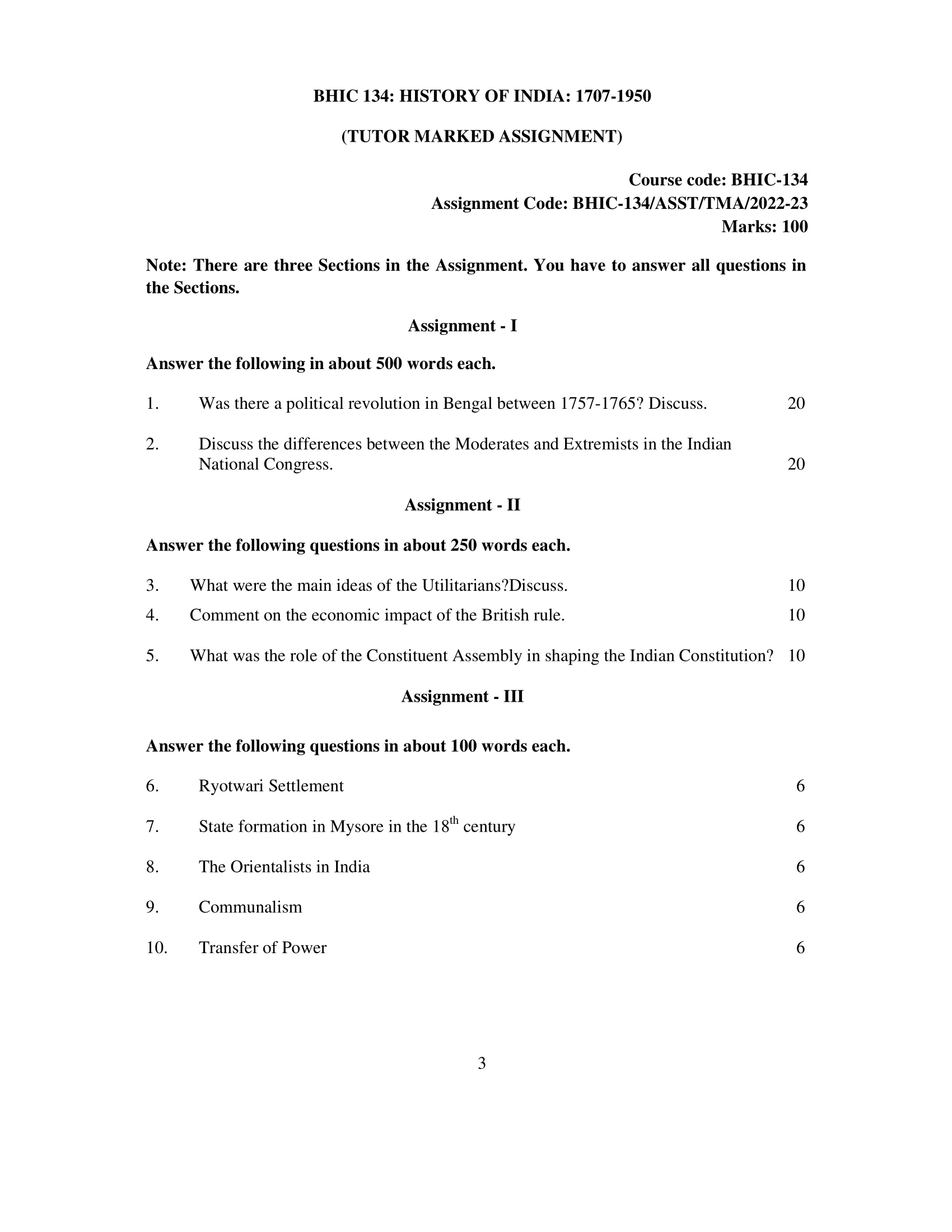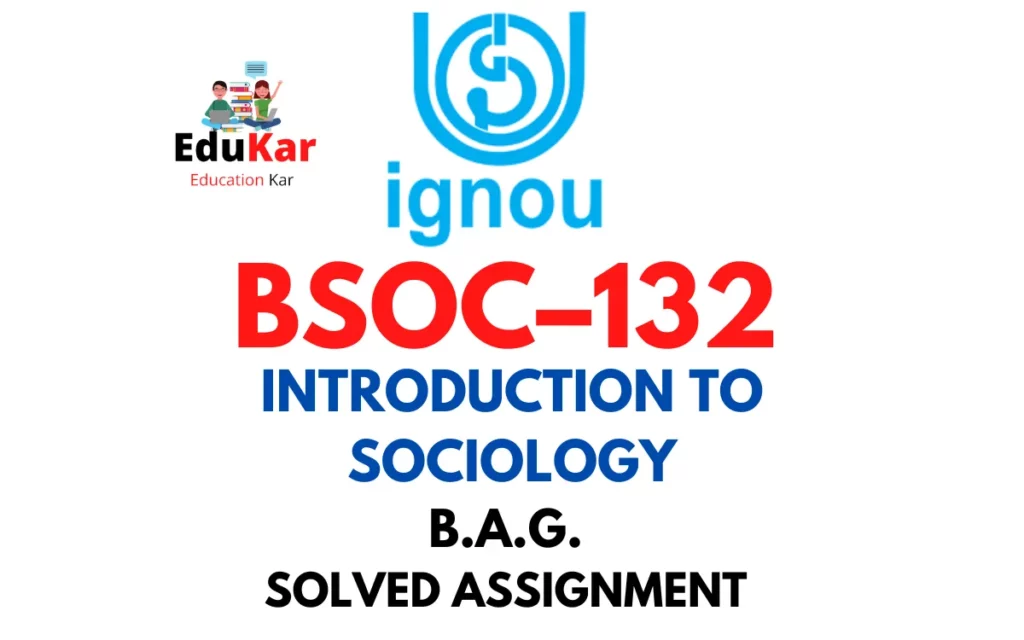Contents
- 1 Assignment – I
- 2 Answer the following in about 500 words each.
- 3 1. Was there a political revolution in Bengal between 1757-1765? Discuss.
- 4 2. Discuss the differences between the Moderates and Extremists in the Indian National Congress.
- 5 Assignment – II
- 6 Answer the following questions in about 250 words each.
- 7 3. What were the main ideas of the Utilitarians?Discuss.
- 8 4. Comment on the economic impact of the British rule.
- 9 5. What was the role of the Constituent Assembly in shaping the Indian Constitution?
- 10 Assignment – III
- 11 Answer the following questions in about 100 words each.
- 12 6. Ryotwari Settlement
- 13 7. State formation in Mysore in the 18th century
- 14 8. The Orientalists in India
- 15 9. Communalism
- 16 10.Transfer of Power

| Title | BHIC-134 |
| University | IGNOU |
| Degree | Bachelor Degree Programme |
| Course Code | BHIC-134 |
| Course Name | HISTORY OF INDIA: 1707-1950 |
| Programme Name | Bachelor of Arts (General) |
| Programme Code | BAG |
| Total Marks | 100 |
| Year | 2022-2023 |
| Language | English |
| Assignment Code | BHIC-134/ASST/TMA/2022-23 |
| Last Date for Submission of Assignment: | For June Examination: 31st March For December Examination: 30th September |

Assignment – I
Answer the following in about 500 words each.
1. Was there a political revolution in Bengal between 1757-1765? Discuss.
Ans: Yes, there was a political revolution in Bengal between 1757 and 1765. This period marked the end of the rule of the Mughal Empire in Bengal and the beginning of British colonial rule. The revolution was triggered by the Battle of Plassey, fought on June 23, 1757, between the British East India Company and the forces of Siraj-ud-Daula, the Nawab of Bengal. The British emerged victorious and established their control over Bengal.
The British East India Company had been trading in Bengal for several decades, but the Battle of Plassey allowed them to establish a dominant position in the region. The company became the de facto ruler of Bengal and the Nawab was reduced to a mere figurehead. The company’s monopoly over trade in Bengal and its control over revenue collection allowed it to amass great wealth and power. This marked the beginning of British colonial rule in India, which would last for more than two centuries.
The revolution had far-reaching consequences for Bengal and India as a whole. The British East India Company established a new administrative system in Bengal, which was characterized by a high degree of centralization and the establishment of a bureaucracy. The company also introduced new forms of taxation, which increased the burden on the common people. The British also started to interfere in the internal affairs of Bengal, including the administration of justice and the distribution of land.
One of the most significant consequences of the revolution was the decline of the indigenous textile industry in Bengal. The British East India Company had a monopoly over trade in textiles, which meant that the local producers could not compete with the company’s imported goods. This led to the decline of the indigenous textile industry and a shift towards cash crops such as indigo and opium, which were grown for export to Britain.
2. Discuss the differences between the Moderates and Extremists in the Indian National Congress.
Ans: The Indian National Congress, established in 1885, was a major political organization that played a key role in India’s struggle for independence from British rule. During its early years, the Congress was dominated by moderate leaders who advocated for gradual reforms and worked within the framework of British rule to bring about change. However, by the early 20th century, a new generation of leaders, known as the extremists, emerged within the Congress who were dissatisfied with the moderate approach and called for more radical and immediate action.
The moderates, such as Gopal Krishna Gokhale and Dadabhai Naoroji, believed in working within the existing political system to achieve their goals. They advocated for constitutional reforms, such as greater representation in government and the expansion of civil liberties, and sought to educate the public about the importance of political participation. The moderates also believed in working with the British government to bring about change and sought to establish a cordial relationship with the colonial power.
In contrast, the extremists, such as Bal Gangadhar Tilak and Bipin Chandra Pal, were dissatisfied with the moderate approach and called for more radical action. They believed that the British government was not willing to make meaningful concessions and that direct action was necessary to achieve their goals. The extremists advocated for the use of mass agitation, such as strikes and boycotts, to pressure the British government into making concessions. They also sought to inspire nationalist feelings among the Indian people and to cultivate a sense of pride in Indian culture and heritage.
The differences between the moderates and the extremists reflected broader debates about the best strategies for achieving Indian independence. The moderates believed in working within the existing political system to bring about change, while the extremists believed that more radical action was necessary to achieve their goals. The extremists were more critical of British rule and believed that the British government was not willing to make meaningful concessions.
The differences between the moderates and the extremists also reflected different visions of the future of India. The moderates believed in preserving India’s cultural heritage and working within the framework of British rule to bring about change, while the extremists sought to create a new India that was free from British influence and that celebrated Indian culture and heritage.
Assignment – II
Answer the following questions in about 250 words each.
3. What were the main ideas of the Utilitarians?Discuss.
Ans: Utilitarianism is a philosophical and ethical theory that advocates for maximizing overall happiness and well-being in a society. The main ideas of utilitarianism can be traced back to the works of Jeremy Bentham and John Stuart Mill in the late 18th and early 19th centuries.
The central tenet of utilitarianism is the principle of utility, which states that an action is right if it leads to the greatest overall happiness for the greatest number of people. Utilitarians believe that happiness can be quantified and that it is the ultimate goal of human life. They also believe that an action is moral if it increases the overall happiness of society and that an action is immoral if it decreases the overall happiness of society.
Bentham and Mill both emphasized the importance of individual liberty and personal autonomy in the utilitarian framework. Bentham believed that government policies should be based on the principle of utility and that the aim of government should be to promote the greatest happiness of the greatest number. Mill believed that individual liberties, such as freedom of speech and religion, are essential for maximizing overall happiness and that government intervention should be limited in order to preserve these liberties.
Utilitarianism has been used as a basis for various political and economic policies, such as the idea of social welfare programs aimed at maximizing overall happiness and well-being in a society. The theory has also been criticized for its focus on the aggregate happiness of a society and for ignoring the needs and happiness of individual members.
4. Comment on the economic impact of the British rule.
Ans: The British rule had a profound impact on the economy of India, which was one of the largest and most prosperous economies in the world prior to British colonial rule. The impact of British rule can be analyzed in terms of its effects on agriculture, industry, trade, and taxation.
Agriculture was the backbone of the Indian economy prior to British rule, and the British imposed a series of policies that had a significant impact on the sector. British policies led to the conversion of fertile land to export crops such as opium, indigo, and tea, which had a detrimental effect on food production. The British also implemented a land revenue system that favored the interests of British landowners over those of Indian farmers, leading to the widespread exploitation of farmers and the decline of the agricultural sector.
Industry also suffered as a result of British rule. The British implemented policies that favored British industries over Indian ones, such as high tariffs on Indian goods and the promotion of British goods through trade. The British also introduced new technologies and systems of production that led to the displacement of traditional Indian industries.
Trade was also greatly impacted by British rule, with the British implementing a policy of mercantilism that favored Britain over India. The British established a monopoly over Indian trade, with the majority of India’s exports going to Britain and British goods being imported into India. The result was that India became a source of raw materials and a market for British goods, with India’s trade deficit with Britain increasing over time.
The British also imposed a series of taxes on the Indian population, including taxes on land, salt, and other necessities. The taxes were used to finance British administrative expenses and military operations in India, leading to widespread poverty and economic hardship among the Indian population.
5. What was the role of the Constituent Assembly in shaping the Indian Constitution?
Ans: The Constituent Assembly of India played a critical role in shaping the Indian Constitution, which serves as the supreme law of India to this day. The Constituent Assembly was established in 1946 with the goal of drafting a new constitution for India that would replace the Government of India Act 1935.
The Constituent Assembly consisted of elected representatives from various states and territories in India, and its members were charged with the task of creating a constitution that would reflect the aspirations and values of the Indian people. The Assembly was also responsible for deciding the form of government that India would have, the rights and freedoms that would be guaranteed to citizens, and the distribution of power between the central government and the states.
The Assembly was guided by the principles of democracy, secularism, and federalism, and its members engaged in lively debates and discussions to reach a consensus on various issues. The Assembly was influenced by a variety of sources, including the Indian independence movement, the Constitution of the United States, and the constitutions of other countries.
The Assembly’s work was finally completed in 1949, and the Indian Constitution was adopted on 26th November of that year. The Constitution of India is considered one of the most comprehensive and progressive constitutions in the world, and it has been amended several times over the years to reflect the changing needs and aspirations of the Indian people.
Assignment – III
Answer the following questions in about 100 words each.
6. Ryotwari Settlement
Ans: The Ryotwari settlement is a system of land tenure and revenue collection in India, primarily used in the southern states. In this system, the ownership of land is directly with the cultivator (the “ryot”) and the revenue is collected directly from the cultivator by the government. The Ryotwari system is characterized by the absence of intermediaries, such as zamindars or intermediaries, between the government and the cultivator. The system is used in areas with scattered and isolated holdings and is considered more suitable for areas with a large number of small cultivators. The Ryotwari system has been in existence in India for several centuries and continues to be used in many parts of the country today.
7. State formation in Mysore in the 18th century
Ans: The state formation in Mysore in the 18th century was marked by the rise of the Wodeyar dynasty and the expansion of their territory through military conquests and strategic alliances. Under the leadership of the warrior-king, Hyder Ali, Mysore emerged as a major power in southern India and challenged the dominant Maratha and British empires. Hyder Ali’s son, Tippu Sultan, continued the expansionist policies of his father and strengthened Mysore’s military capabilities. However, Tippu Sultan’s defiance of the British ultimately led to his defeat in the Fourth Anglo-Mysore War and the eventual annexation of Mysore by the British East India Company in 1799. Despite British rule, the legacy of the Wodeyar dynasty and their state formation in Mysore continue to shape the region’s political and cultural identity.
8. The Orientalists in India
Ans: The Orientalists in India were a group of European scholars who were interested in the study of Indian history, culture, and languages. They arrived in India during the colonial period and sought to understand the country’s rich heritage and diverse traditions. The Orientalists were largely responsible for the development of the field of Indology, which encompasses the study of Indian literature, philosophy, religion, and art. They also made important contributions to the study of Sanskrit, Pali, and Persian and helped to preserve many ancient texts that might have otherwise been lost. Despite the valuable contributions of the Orientalists, their work was also shaped by the colonial context in which it was produced, and their views of India and its people were sometimes influenced by colonial prejudices and stereotypes.
9. Communalism
Ans: Communalism is a political ideology that promotes the interests of a particular religious or ethnic community above those of other communities. It often leads to the division of society along religious or ethnic lines and creates tensions between different communities. In India, communalism has been a major source of conflict and has led to several incidents of violence, including communal riots. The ideology of communalism is based on the belief that people of different religious or ethnic backgrounds cannot coexist peacefully and that separate communities must be established for each group. This ideology has been used by political leaders to mobilize support for their causes and to gain power by playing on the fears and prejudices of different communities. The fight against communalism is an important aspect of India’s struggle for social justice and equality.
10.Transfer of Power
Ans: The Transfer of Power was the process by which British colonial rule in India was ended and India became an independent nation in 1947. The transfer was marked by the transfer of legislative power from the British government to the Indian National Congress and other Indian leaders, as well as the transfer of administrative power from British officials to Indian officials. The transfer was the result of years of political struggle and negotiation between Indian leaders and the British government, and it was facilitated by the Indian Independence Act of 1947. The transfer was marked by significant violence and instability, particularly in the aftermath of partition, which led to the mass migration of millions of people and the deaths of hundreds of thousands of people. Despite these challenges, the transfer of power remains one of the most significant events in Indian history, marking the birth of a new nation and the beginning of a new era in India’s history.
How to Download BHIC-134 Solved Assignment?
You can download it from the www.edukar.in, they have a big database for all the IGNOU solved assignments.
Is the BHIC-134 Solved Assignment Free?
Yes this is absolutely free to download the solved assignment from www.edukar.in
What is the last submission date for BHIC-134 Assignment?
For June Examination: 31st March, For December Examination: 30th September
















